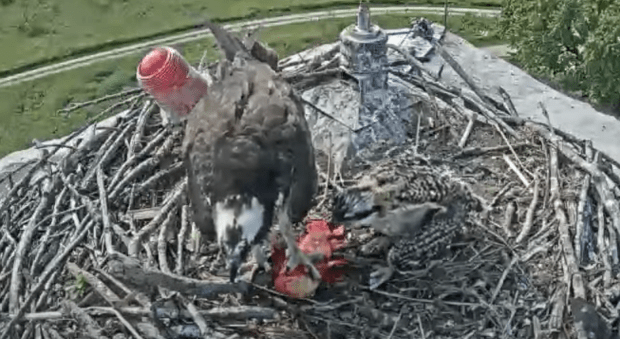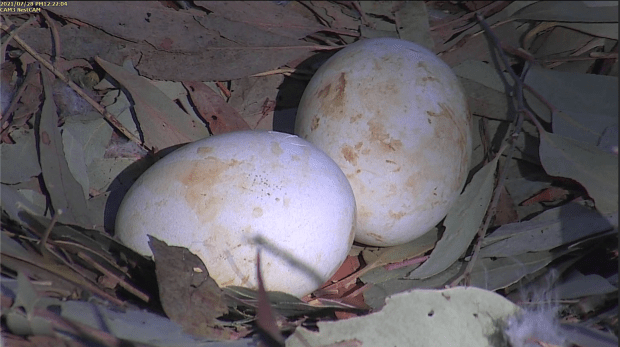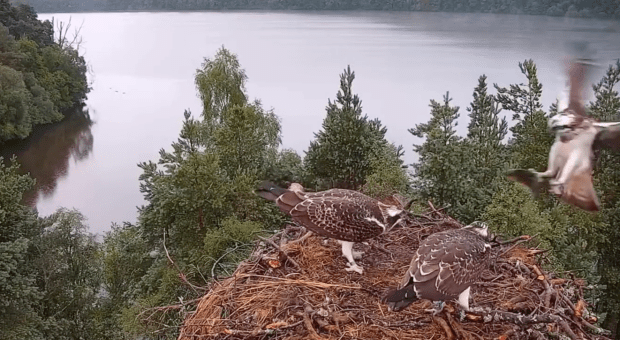My virtual friend ‘S’ and I probably never thought we would be pouring over fish ID charts trying to identify partially eaten fish. OK. I can’t fully speak for her but even growing up with a dad who lived to fish, a son that travels the world to fish and feels more at home in a boat than on land, and a grandson that fishes in all his spare time – I never thought for a second I would spend more than a few minutes looking at the type of fish the Ospreys are eating. Surprise. The fish that comes to the Collins Marsh Osprey nest is making some of us very curious as to what it is and where mum is catching it.
The DNR of Wisconsin is great. They have games you can plan, fish ID charts by name or identifying marks. It was not until I found their posters today that I even believed there was hope of figuring out this fish. It looks like my late mother’s Siamese Fighting Fish but for its colour and size.

Seriously I thought that the Mum at the Collins Marsh Osprey Nest had found someone’s ornamental fish pond to raids. This is at least the second fish of this species brought to the nest in a 24 hour period.
These are some of the top game fish in Wisconsin but nope. Nothing on this poster resembles that fish.

It isn’t a Roach but it could be a Rudd. But the Rudd hasn’t got red scales! There are suckers that look like a closer match.

This is beginning to drive me a little nuts. And don’t be shy. If you recognize that fish the mum is feeding her chick – tell me. I will be smiling for a week. Tomorrow I am going to ask the Naturalist at Collins Marsh. To be continued.

Dad was only seen on the Collins Marsh nest once today. Mum was busy bringing in these smaller fish for her and the chick. It is a good thing that she isn’t afraid to get wet – because if she were her baby would not be alive.

The chick will eat this species but it is certainly not its favourite and Mom, on the other hand, seems to like it or is so hungry she leaves hardly any scraps.
Speaking of eating, the female at the Bucovina Golden Eagle Nest brought in an Eurasian Hare for Zenit. Zenit wasn’t close to the nest tree when mum arrived and called but he quickly comes in mantling like crazy. When you see this eaglet or any of the fledgling Osprey aggressively going after prey, the term is hyperphagia. Every bird that migrates needs to eat as much as they can – compulsive overeating – in order to store fat for their migratory journey.
Lady Hawk caught all of the action and Zenit’s enormous crop in a video:
Some of the biggest news of the day is that 8:54 am on 28 July a pip was first noticed in one of the two eggs of Lady and Dad, White Bellied Sea Eagles, whose nest is in an Ironbark Tree in the Sydney Olympic Forest.

This was Lady checking, listening, and gently rolling the eggs about forty minutes later.

There is now a hole in that egg. So hatch is close.

I adore the little sea eaglets but this nest really broke my heart last year with WBSE 26 striving to live, to fly, to be a bird and then to have it end with her being euthanized.
I have seen prosthetic legs made for birds, 3D printed beaks for eagles, sophisticated operations on the webbed feet of Canada geese, and more. I have witnessed pain management programmes for animals in care and wildlife rehabbers like those at A Place Called Hope in Connecticut that not the extra mile – they go ten extra miles. All we have to do is remember the state that The Old Warrior was in when he arrived at their clinic. His lead levels were 48, he had multiple fractures in his leg, and his beak was so damaged that he could hardly eat. That old eagle wanted to live and he was treated accordingly. His lead levels are around 10, he is eating well, his feather condition is improving all the time. He is happy! Today he remains with the clinic as they await a permit for him to be their ‘forever Warrior’. I had hoped, like so many others, that something would be done to help 26.
There are several ways to access the cam for the sea eagles. There is even one with a chat room. I will try and locate those other links for you.
Here is cam 4. The definition is good.
I want to thank a follower from Poland who sent me a note suggesting I look at the beautiful stork nest in Ostroleka, Poland. So I did! There were five storks sleeping on this nest in the northeast of Poland.

What a picturesque village. The farmer’s fields are so lovely. Tranquil is the word I want to use as the sun rises on a new day.

I need to find out more about this nest which I will do in the coming days. I am trying to imagine the challenges for the parents to feed five – or is it four chicks and the parent is off the nest? Here is the link to the camera for this nest:
Tiny Little is not sleeping on the Foulshaw Moss Nest tonight. It is not clear to me whether he had a fish drop later last night or not. But after waiting for big sibling to get their fill of a large fish, Tiny Little is now eating for sure. It is 17:01 on the Foulshaw Moss Osprey Nest.

Of course, big older sister is sitting there waiting in line! Poor things. They always get caught up spending so much time around the cheek and mouth, the bony bits. Hopefully Tiny Little will get full before it gets tired.

I love it when the mother’s get out there fishing. We see that in the mom at the Collins Marsh Nest and here comes NC0 at the Loch of the Lowes.


That fledgling just about tore her leg off! I am looking at those strong thin legs of NC0. She has been diving and bringing in fish to this nest for at least a month. Soon she is going to have to begin bulking up for her flight to Africa. It’s that word: hyperphagia.

It has been a pretty exciting day. So nice to see some of the fledglings on the nests! It is comforting to know that they are surviving.
Thank you so much for joining me. I hope that everyone has a great day. Take care. See you soon.
Thank you to the following for their streaming cams where I took my screen shots: Collins Marsh Osprey Nest and the Neustadlter Nature Center, Cumbria Wildlife Trust and the Foulshaw Moss Osprey Nest, Sea Eagles, Birdlife, and Sydney Discovery Center, Ostrolekas White Stork Nest, and Scottish Wildlife Trust and Friends of Loch of the Lowes. I would also like to thank the Wisconsin DNR for the fish poster files and ‘S’ for sending me that great shot of that ‘gold’ fish.
